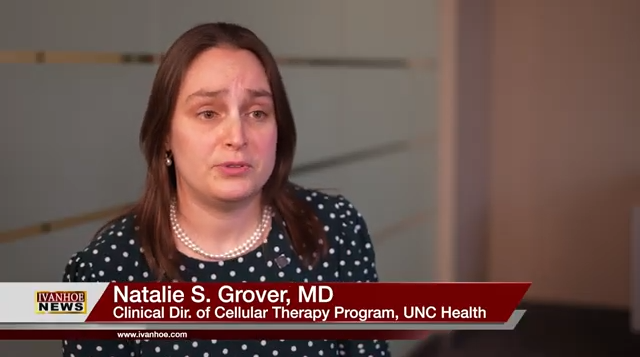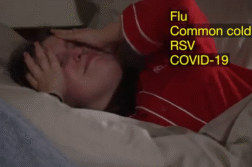Natalie S. Grover, MD, Clinical Director of Cellular Therapy Program at UNC Health, talks about treating a type of lymphoma with CAR T-cell therapy.
Interview conducted by Ivanhoe Broadcast News in 2024.
What is large B cell lymphoma?
Grover: Lymphoma is a cancer of the immune system. It’s a cancer of your immune cells and specifically a cancer of your white blood cells. When we think about lymphoma, we think of aggressive lymphomas and slow growing lymphomas and large B cell lymphoma is the most common type of aggressive lymphoma.
How is it usually treated?
Grover: Large B cell lymphoma at diagnosis is usually treated with chemotherapy. So it’s generally treated with a combination of chemotherapy and immunotherapy. A large number of patients are cured with their initial therapy and don’t need any other therapy afterwards.
What if you’re not sure what happens?
Grover: Although most people are cured with initial therapy, unfortunately, there’s still a large number of patients that have disease that either doesn’t respond to chemotherapy or progresses after time after initial therapy. For those patients, they’re now more and more options available now, and that’s when we think about CAR T-cells or other types of therapy, either chemotherapy or targeted therapies that are becoming available for these patients.
Tell me a little bit about CAR T-cell therapy.
Grover: CAR T-cell therapy is a type of immunotherapy. It’s using a patient’s own immune cells to specifically target them to a marker on the lymphoma cells. Enlarged B cell lymphoma is a cancer of your B cells and B cells have a common target, CD19, so there’s a target that can be more easily targeted for patients of lymphoma. So the principle behind CAR T-cells is taking a patient’s own T-cells, their own immune cells, and then manufacturing them, changing them so they specifically target a marker on the patient’s lymphoma. So the patient starts with getting their blood collected and then they get manufactured to create these CAR T-cells that are now the T-cells are now specifically targeted to attack their cancer cells.
How much blood do you have to take? Is it through an IV and then do you put it back in through an IV or is it directly into the area?
Grover: Basically, when a patient undergoes collection, usually they have to have a catheter placed, a special central line where they go and they have their blood drawn to get sent out for manufacturing of the CAR T-cells. And then when they get back the CAR T-cells, it’s through an IV.
Is it a one-time IV?
Grover: For the collections, usually they get a catheter place that day for the collection, and then that’s usually taken out. So that doesn’t stay in from that standpoint.
Do they have to do this repeatedly?
Grover: The collection is a one time process. When they get the CAR T-cells, it’s also one time process. One of the advantages of CAR T-cells is that it’s a one time treatment that generally we think of it as a one time infusion.
How quickly do patients see a response?
Grover: Once patients are treated with CAR T-cells, we generally re-scan them about a month after treatment, and usually at that time, we’re able to see a response. Sometimes even earlier, within a week or two of treatment, patients may feel that their lymph nodes shrinking and they may see may see changes at that time. But generally, we usually scan them at one month to see what the response looks like.
Are there side effects to this?
Grover: With CAR T-cells, there are specific side effects that we look at. So there are some side effects that we think of as being more early side effects that we see during the first month of treatment. The most common side effects we think of in that setting are one side effect is cytokine release syndrome, and that’s basically an immune reaction to the CAR T-cells. When that occurs, usually it starts off of a fever and then patients may just have a fever or they may have more significant side effects such as low blood pressure, or low oxygen where they need more oxygen support or fluids or support of their blood pressure. We’re much better at managing that and are treated earlier. So most of the time, it tends to be less severe. The other side effects that we think of within the first month of CAR T-cells is neurotoxicity. So some patients see this neurotoxicity , which usually starts off with some confusion and word finding difficulties. That’s generally what it is for most patients that experience it, but once in a while it can become more severe and really rare cases where patients may have seizures or brain swelling. We also better at identifying and treating it early with steroids.
How long do you see these CAR T-cells fighting the lymphoma?
Grover: It depends on the products. So the CAR T-cells, when we check in the blood, depending on the product and with some types of products, you may only see CAR T-cells in the blood for a few months, but even afterwards, your immune system is trained to fight your lymphoma. With other types of products, you may see it. You may see some even low levels of CAR T-cells in the blood for longer periods of time, even years.
Now, we’re going to talk to the patient, John Bell. Do you know him?
Grover: Yes.
Can you tell me a little bit about when you first met him and what his health was like at that point?
Grover: When I first met him, he had lymphoma that had unfortunately relapsed after relapsed, after initial therapy, and his doctor had put him on another type of chemotherapy. His disease wasn’t responding to other chemotherapy as well. So he was running out of options for treating his lymphoma unfortunately. So when I when I met him, he was having some symptoms from his lymphoma and we were talking about other treatment options at that point.
His options are running out. Is his life threatened?
Grover: Yes. So definitely CAR T-cells definitely improved the life expectancy for these patients.
What would have been John’s life expectancy?
Grover: That’s a good question. I think some of it’s changing a little bit because in addition to CAR T even since I’ve seen John, the changes, there’s been newer drugs and treatments approved for large lymphoma. There would be more options now than there were years ago when I saw John. Initially, before CAR T for patients who had been refractory and not been able to get into remission, their life expectancy was measured in months at that point. Now we do with CAR T and with some other newer treatments for lymphoma, we’re seeing much better outcomes we’re potentially able to cure patients who at that point wouldn’t have had an option for cure.
Is John in remission? Is he cured?
Grover: He’s several years out from CAR T and doing really well. So the hope is that he’s cured. With lymphoma, it’s hard to say. With any type of cancer, it’s hard to say 100% that someone’s cured, but it’s a really good sign that he’s been so many years out in remission. So hopefully cured.
Would this ever become a replacement for something as toxic as chemotherapy?
Grover: That’s a good question. So even since John treatment, things would have been would have been a little bit different now. So when I had seen John, he had gotten initial chemotherapy and then he had gotten additional chemotherapy because at that time, CAR T-cells were only approved after two what we call lines of therapy or two different types of treatments. Since then, it’s been shown that there was a clinical trial looking at CAR T-cells before second line. So looking at CAR T-cells after progression after an initial therapy, and that has shown a benefit and even overall survival benefit. So it seems that patients are living longer if you’re giving them CAR T-cells earlier. Now for large B cell lymphoma, CAR T-cells are approved after they progress from initial therapy. Even now they’re being moved to earlier lines of therapy. There’s definitely interest in potentially continue to move CAR T-cells earlier and earlier. There’s still some challenges with that. So some of it is around costs, and logistics, CAR T-cells are expensive, and it takes a while. It’s a personalized therapy for each patient. It’s extremely expensive. So there’s not access for all patients, and right now they can only be given at specialized centers. So most oncologists can treat newly diagnosed patients of large B lymphoma but an oncologist CAR T-cells have to be given at specific centers specific specialized centers. There’s also issues around access, which is improving, but it’s still there. And of course, even though CAR T-cells are generally thought to be preferable to potentially the several cycles of chemotherapy. We’re not treating large B cell lymphoma with? They still do have some unique toxicities and there’s some more longer toxicities and also risks of infection and other things that we’re still learning about. So even though it’s a great treatment and has really revolutionized how we treat lymphoma, there’s still more research to be done about where they fit in.
Can you compare a cost of chemo to a round of chemo for someone like John to the CAR T-cell?
Grover: I don’t know what different chemotherapy costs, but the cost of CAR T-cells around $500,000 in that range and that’s just for the product that doesn’t include the collection costs and the cost if someone been- if someone’s hospitalized with side effects and and all of that. That being said, of course, if someone has relapsed disease and disease keeps coming back, they keep having to get more therapies and may have to come into the hospital. Potentially that one time cost may still be worthwhile compared to the cost of all these other treatments, but it is still something that’s very expensive.
What’s next for CAR T-cells you talk a little bit about that?
Grover: In terms of thinking about CAR T-cells, some of the things that we’re really thinking about is there are patients like John who did really well. He’s a success story that’s wonderful. But there’s also people who unfortunately are treat of CAR T-cells, but then relapse or don’t respond. One question is figuring out why some patients respond and and or why other patients don’t respond well to CAR T-cells. There’s questions around improving the effectiveness of the CAR T-cells that we have for lymphoma. There’s also, of course, interest in moving CAR T-cells to other diseases. Looking at new targets, and we have some research here studying CAR T-cells for other types of diseases with other targets. One of the other interests is looking at what we call off the shelf CAR T-cells or CAR T-cells that are made from donors blood as opposed to the patient’s blood, so they can be available more quickly for patients.
END OF INTERVIEW
This information is intended for additional research purposes only. It is not to be used as a prescription or advice from Ivanhoe Broadcast News, Inc. or any medical professional interviewed. Ivanhoe Broadcast News, Inc. assumes no responsibility for the depth or accuracy of physician statements. Procedures or medicines apply to different people and medical factors; always consult your physician on medical matters.
If you would like more information, please contact:
Kendall Daniels
Kendall.daniels@unchealth.unc.edu
Sign up for a free weekly e-mail on Medical Breakthroughs called First to Know by clicking here




